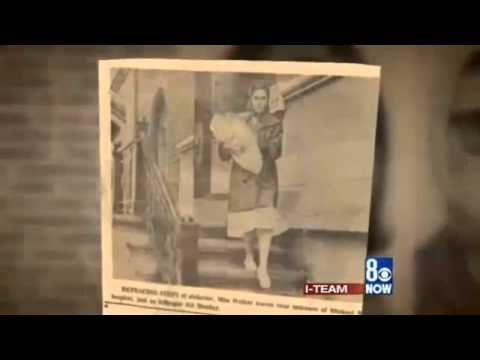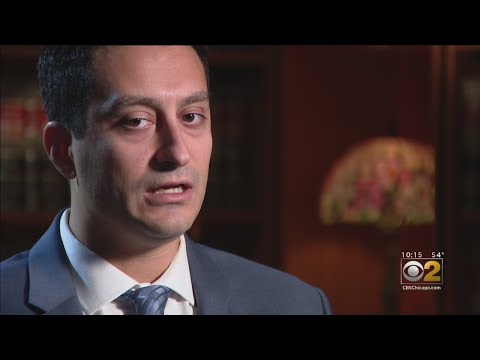Earlier this year, we published a list about mysteries that we’ve been following which have had some major recent developments. The number of cold cases with major developments has only increased within the last several months, and this has necessitated another list. Since many of the following cases have been featured on our website in the past, it seems, once again, that Listverse might be a good luck omen.
10 The Disappearance Of The Lyon Sisters
In 1975, the town of Wheaton, Maryland, was traumatized by one of the most famous missing children cases of all time. On the afternoon of March 25, the Lyon sisters, 12-year-old Sheila and 10-year-old Katherine, went to the Wheaton Plaza Shopping Center but never returned home. There were numerous leads, one of which was an eyewitness account from 18-year-old Lloyd Lee Welch, who claimed that he saw the two girls leaving the mall in a car with an unidentified man. Welch took a polygraph test which seemed to indicate deception, and his lead went nowhere. It would be nearly 40 years until Welch was conclusively linked to the disappearances. Watch this video on YouTube In 2013, the case was reopened after investigators noticed a resemblance between Welch and a sketch of a man who was seen talking to the Lyon sisters at the mall. By this time, Welch was serving a 30-year sentence in a Delaware prison for sexually assaulting a 10-year-old girl. When questioned, Welch confessed that both he and his uncle, Richard Welch, abducted the girls. Lloyd claimed that he witnessed his uncle sexually assaulting one of the sisters but denied any involvement in their deaths. However, two of Lloyd’s cousins have claimed that they saw him throw two large, red-stained duffel bags onto a fire on the family’s property on Taylor’s Mountain in Virginia, creating a foul stench. In July 2015, Lloyd Lee Welch was indicted on two counts of first-degree murder. Authorities have not ruled out the possibility that others were involved in the crime, and Richard Welch’s wife has been charged with perjury for lying in front of a grand jury. Searches have been conducted on the Welch family property for the remains of the Lyon sisters, but nothing has been found.
9 The Identity Of ‘Paul Fronczak’
On July 2, 1965, an abandoned male toddler was found in a stroller in front of a store in Newark, New Jersey. Investigators came to believe that the boy was Paul Fronczak, a newborn infant who had been abducted from a Chicago hospital in August 1964. Paul was reunited with his parents, who raised them as their son. However, as he got older, Paul noticed that he bore no resemblance to the rest of his family, and he began to believe that a case of mistaken identity might have occurred. In 2012, DNA testing confirmed that he had no biological connection with his family and was not actually Paul Fronczak. Three years later, “Paul” finally uncovered his true identity, and believe it or not, it only opened the door to another strange mystery. In June 2015, the former Paul Fronczak announced that genetic genealogist CeCe Moore had used DNA data banks to match him to his real biological family. Though the family’s surname has not been released for privacy reasons, “Paul” learned that his real name was “Jack” and that he had four siblings. However, the most shocking revelation was that Jack had a twin sister named Jill, who had also mysteriously gone missing. According to their siblings, Jack and Jill both disappeared before their second birthday. Their parents told the rest of the family that they were now living with other relatives and ordered them to never mention the twins again. Photos of Jack and Jill were also removed from family photo albums. Since the twins’ parents are now deceased, there are still no answers about Jack’s abandonment, the unexplained disappearance of his twin sister, or the fate of the real Paul Fronczak.
8 The Identity Of ‘Benjaman Kyle’
One of the most mysterious amnesia cases of all time involved an individual known as “Benjaman Kyle.” On August 31, 2004, an unconscious nude man who appeared to be in his fifties was found in a dumpster behind a Burger King in Richmond, Georgia. It appeared that he had been struck on the head with a blunt object, and he had no memory of anything that happened and did not even remember his own name. Doctors determined that he was suffering from retrograde amnesia. Since he was found near a Burger King, the man decided to use the “B.K.” initials to select a new name for himself—Benjaman Kyle. Over the course of the next decade, all attempts to uncover Benjaman Kyle’s true identity went nowhere. DNA testing and fingerprint checks turned up empty, and even though Benjaman’s story received a lot of media coverage, no one seemed to recognize him. Since he had no identity, Benjaman could not obtain a Social Security number, so he was forced to work under the table and rely on the kindness of others to survive. Finally, in September 2015, Benjaman publicly announced that CeCe Moore (the same genetic genealogist who helped the former Paul Fronczak) had used his DNA samples to match him with his biological family. He was originally from Indiana and had apparently broken off all contact with his family, who had not seen him since 1976. The former Benjaman Kyle has since tracked down his original birth certificate and Social Security records and used them to obtain a new identification card under his real name. He has plans to reunite with his family, but for the moment, he is keeping his true identity a secret from the public.
7 The Disappearance Of Zebb Quinn
On the evening of January 2, 2000, 18-year-old Zebb Quinn left his job at Walmart in Asheville, North Carolina, and disappeared under very bizarre circumstances. Two weeks later, Zebb’s abandoned car was found near the hospital where his mother worked. A pair of lips was drawn on the back of the windshield in lipstick, and the vehicle contained several items which did not belong to Zebb, including a Labrador puppy. There were numerous persons of interest in Zebb’s disappearance, including a woman Zebb was romantically interested in, as well as her abusive boyfriend. However, a lot of attention focused on his coworker, Robert Jason Owens, the last known person to see Zebb alive. According to Owens, Zebb had driven off shortly after they left the Walmart together, but Owens displayed a lot of suspicious behavior. He was treated for injuries the morning after Zebb’s disappearance, providing an unverified and unbelievable story about sustaining them in a car accident. A few days later, Owens impersonated Zebb during a phone call in which he called in sick for work. Over the next several years, Owens served numerous stints in prison for minor crimes, but things got serious in March 2015, when Owens was charged with the murders of a couple in Leicester. The victims were Joseph “J.T.” Codd and his pregnant wife, Cristie Schoen Codd. Owens had been hired to perform construction on their house, and it’s believed that he murdered them during a burglary attempt. The couple’s dismembered remains were found inside a wood stove on Owens’s property. Authorities are continuing to perform searches of the property for evidence that Owens was responsible for the disappearance of Zebb Quinn.
6 The Disappearance Of Bonnie Haim
On January 6, 1993, 33-year-old Bonnie Haim disappeared from her home in Jacksonville, Florida. At the time, Bonnie lived there with her husband, Michael, and their three-year-old son, Aaron. According to Michael, he had an argument with Bonnie, and she decided to drive off and never returned. The following day, her purse was found in a motel dumpster near the Jacksonville Airport. Shortly thereafter, Bonnie’s abandoned car was found in the airport parking lot. However, no one really believed that Bonnie ran away voluntarily, and suspicion immediately turned toward her husband. Michael was known for being abusive toward Bonnie, and she was planning to leave him. Bonnie deposited money into a secret bank account and put down a deposit on a new apartment, and Michael reportedly became enraged when he found out. After Bonnie’s disappearance, the couple’s son was interviewed by a child psychologist. The impression Aaron gave was that he had witnessed his father murder his mother before removing her body from the house. Due to Aaron’s young age, his testimony was not considered to be strong enough evidence to file charges against Michael. However, Michael eventually lost custody of his son, and his house was seized after losing a civil suit to Bonnie’s family. In December 2014, the owners of the Haims’ former house were digging an old pool out of the backyard when they came across skeletal remains. Eight months later, DNA testing confirmed that the remains belonged to Bonnie Haim. Michael Haim was immediately arrested and charged with his wife’s murder.
5 The Identification Of ‘Marie’
At approximately 1:00 AM on June 9, 1973, a man named Lawrence Dorn was arguing with a teenage girl at an intersection in St. Petersburg, Florida, when he suddenly shoved the girl into the path of an oncoming car. She was struck and dragged over 30 meters (100 ft), dying instantly. Dorn was arrested and charged with the girl’s murder. He claimed that he shoved the girl in self-defense. His charge was reduced to manslaughter and then dropped altogether because the prosecution couldn’t prove intent. The strangest aspect of this story was that no one in the area knew the girl’s true identity. She had introduced herself with such names as “Janice Marie Brock” and “Janice Marie Bromke,” but most people knew her as “Marie.” Marie had claimed that her birth date was June 17, 1953, but she appeared to be younger. All attempts to uncover her identify her went nowhere. The case remained cold until January 2015, when a man named Timothy Young reported to police that he had seen a composite sketch of Marie online and believed that she resembled his older sister, Janice Marie Young, who had been missing for over 40 years. Timothy and Janice both endured abusive childhoods and were molested by a relative. They were eventually taken away from their family, whose surname was “Brock,” and adopted by the Young family in Newport News, Virginia. At age 16, Janice ran away from home, and that was the last her brother saw of her. Finally, in May, DNA testing confirmed that “Marie” was indeed Janice Marie Young.
4 The Identification Of The Dana Point Jane Doe
On the morning of September 20, 1987, a young woman’s body was found on a beach near Dana Point, California. The woman looked to be 18–23 years old and had fallen to her death from a cliff. A number of items were found at the top of the cliff, including a purse and a map with the phone number for a cab company written on it. The woman carried no identification, though her purse did have an embossed name—Carol Pinkham. Investigators did track down a woman named Carol Pinkham, but she had no known connection to the victim and claimed that the purse was stolen from her 12 years earlier. It turned out that the woman had called a cab to pick her up from a gas station in Oso at approximately 4:00 AM. She told the driver that her car had broken down. (No abandoned vehicles were found in the area.) She asked to be taken to the Ritz-Carlton in Laguna Beach, but since she did not have enough money to cover the full trip, the driver took her as far as he could before dropping her off near the cliff area. The woman remained an anonymous Jane Doe for over 27 years, until the case drew the attention of some childhood friends of Holly Jo Glynn, a young woman from Whittier who hadn’t been seen since the 1980s. Finally, in May 2015, DNA testing positively confirmed that Holly Jo Glynn was the Dana Point Jane Doe. Holly was 21 years old at the time of her death, which was ruled to be a suicide.
3 The Wrongful Conviction Of Mario Casciaro
In September 2014, Listverse featured the story of 17-year-old Brian Carrick, who mysteriously disappeared while working a shift at Val’s Food Market in Johnsburg, Illinois, in December 2002. Only weeks after the article was published, it was announced that Carrick’s presumed murderer might have been wrongly convicted for the crime. Even though Carrick’s body was never found, his supervisor at the market, Mario Casciaro, received a 26-year prison sentence for Carrick’s murder in 2013. The prime evidence against Casciaro was the testimony of another coworker from the market, Shane Lamb, who claimed that Carrick was murdered over a drug debt. Watch this video on YouTube However, Lamb would eventually recant his story, claiming that his testimony was false and that Casciaro was completely innocent. The case was further complicated when DNA testing was performed on some blood that was found in the market’s produce freezer shortly after Carrick’s disappearance. The blood did not belong to Casciaro but did match up to another coworker named Robert Render, who died of a heroin overdose in 2012. Once Lamb recanted his testimony, there was no other evidence tying Casciaro to the crime, so his case was heard in front of the Second District Appellate Court of Illinois. In September 2015, they ruled to overturn Mario Casciaro’s conviction, and he was subsequently released from prison. The full truth about Brian Carrick’s disappearance remains a mystery.
2 The Disappearance Of Robin Putnam
On July 7, 2012, 25-year-old college student Robin Putnam hopped on an Amtrak train in California to visit his family in Colorado. At approximately 3:00 AM the following morning, the train made a stop in Salt Lake City, and Robin inexplicably climbed off. He left some of his belongings behind, including his laptop and wallet, and disappeared without a trace. Prior to his disappearance, Robin had been suffering from anxiety attacks and displaying erratic behavior. Since he had allegedly not slept for days before his train trip, all signs seemed to point to him having some sort of mental breakdown. In the months following Robin’s disappearance, there were unconfirmed sightings of him in the Salt Lake City area, suggesting that he might have been wandering the streets as a homeless transient. Robin’s family would spend the next three years searching for him, but the mystery finally came to a tragic end when railroad employees found some skeletal remains next to railway tracks in a remote desert area 24 kilometers (15 mi) outside of Wells, Nevada. Since Robin’s debit card and a set of keys with his name were also found, it seemed likely that the remains were him. Dental records would officially confirm this in August 2015. At the moment, Robin Putnam’s cause of death is unknown, and there are still no answers about why his remains were found over 290 kilometers (180 mi) away from where he was last seen.
1 The Disappearance Of Lynne Schulze
On December 10, 1971, 18-year-old Lynne Schulze exited her dormitory at Middlebury College in Vermont and was heading across campus to take a final exam. Schulze suddenly told her friends that she forgot her favorite pen and headed back to her dorm to get it. This was the last time that anyone ever saw her. Schulze’s baffling disappearance remained a forgotten cold case for over 40 years, until an unlikely series of events pushed it back into the spotlight. In 2015, HBO aired a six-part documentary miniseries called The Jinx, which chronicled the controversial story of eccentric millionaire Robert Durst. Durst had always been the prime suspect in the 1982 disappearance of his wife, Kathleen Durst, and the unsolved 2000 murder of a woman named Susan Berman. In fact, Durst had actually gone on trial for the 2001 murder of a neighbor named Morris Black but managed to get acquitted on the grounds of self-defense. During the filming of The Jinx, new incriminating evidence began to surface against Durst. On March 14, the day before the series finale aired, Durst was arrested for the murder of Susan Berman. Shortly thereafter, a surprising connection was made between Durst and Lynne Schulze. In 1971, Durst and his wife owned a health food store in Middlebury called “All Good Things.” A few hours before she disappeared, Schulze was seen frequenting the store and eating some dried prunes outside. There was also an unconfirmed sighting of Schulze across the street from the store over an hour after she was last seen on campus. While this connection between Robert Durst and Lynne Schulze might be nothing more than a strange coincidence, authorities have not discounted the possibility that Durst murdered other victims, and he has been named as a possible suspect in Schulze’s disappearance. Robin Warder is a budding Canadian screenwriter who has used his encyclopedic movie knowledge to publish numerous articles at Cracked.com. He is also the co-owner of a pop culture website called The Back Row and recently worked on a sci-fi short film called Indefinite Late Fee. Feel free to contact him here.
























